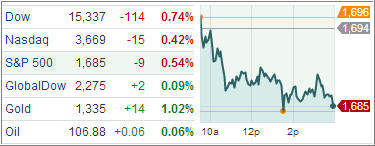Domestic equity markets continued the recent downward trend with trading volumes about 22 percent below the 100-day average. Earnings season is winding down and economic indicators present a mixed view, complicating predictions of the Fed’s next policy action.
Mixed economic data has led to heightened anxiety that the Federal Reserve may begin to taper its asset purchase program this year, possibly as early as September. Equities were confined to a downtrend from the open, and even the news of the first expansionary Eurozone GDP reading in 18 months could not spark a bid.
Nine of ten sectors registered losses while technology posted a fractional gain of 0.01%. The tech sector climbed into the lead early this afternoon. The relative strength of the largest sector component overshadowed the underperformance of chipmakers. While technology was able to end in the green, the materials sector shed 0.2% after spending the majority of the session in positive territory.
On a related note, gold futures climbed 1.1% to $1334.60 per troy ounce. Outside of materials and technology, only energy (-0.4%), financials (-0.4%), and telecom services (-0.2%) ended slightly ahead of the broader market. Meanwhile, several influential sectors weighed. Health care (-0.8%), consumer staples (-0.7%), consumer discretionary (-1.1%), and industrials (-0.8%) lagged.
The discretionary sector was another significant laggard. Retailers registered losses and Macy’s fell 4.5% after missing on earnings and revenue. In addition, the company lowered its full-year 2014 earnings guidance below consensus. Home builders also contributed to the sector’s underperformance. In economic news, refinance activity continued to shrink for the eighth-consecutive week.
The MBA Refinance Index fell 4.4%, reaching its lowest level since April 2011. Mortgage rates remained elevated. The MBA Purchase Index fell 5.4%, the most in six months. The decline in activity suggests housing demand has cooled, as a result of higher mortgage rate.
Elsewhere, the Producer Price Index (PPI) was unchanged in July, below the consensus of 0.3%. Energy prices fell 0.2% led by natural gas. Food prices held steady. Core PPI rose 0.1%, was also below the consensus of 0.2%. On a y/y basis, PPI eased to 2.1% from 2.5%, while the core slipped to 1.2%, the least since June 2010.
This suggests consumer price inflation will also remain subdued. However, many believe the Fed, led by Chairman Ben Bernanke, will probably reduce the central bank’s $85 billion in monthly bond purchases next month, according to 65 percent of economists surveyed by Bloomberg.
In the meantime, our Trend Tracking Indexes (TTIs) softened as well with the Domestic TTI slipping to +2.91%, while the International TTI settled at +6.94%.
Contact Ulli

